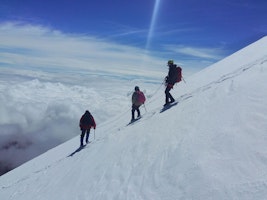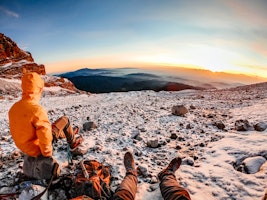Rising more than 5,600 meters above sea level in south-central Mexico, Pico de Orizaba is the tallest mountain in the country and third highest in North America. Also known as Citlaltépetl in the region’s indigenous language, the peak is a dormant stratovolcano which last erupted in the 19th century.
Due to both its location —it can be seen all the way from the Gulf of Mexico— and unique shape, the mountain has various different microclimates and terrains along its slopes.
The volcanic crater at the top is asymmetrical, with its eastern end rising steeply and casting a shadow over the rest of the mountain during the hottest part of the day. This natural phenomenon has allowed a glacier to exist on the northwestern portion of the summit, which is also the least steep and therefore the most popular route taken by mountaineers.
It is widely considered an excellent challenge for people getting into mountaineering. Due to its altitude and topography, it also makes for an excellent training mountain for more experienced climbers eyeing a trip to Denali or the Andes in the near future.
Here are some of the most important things you need to know before planning your own mountaineering adventure to Pico de Orizaba’s summit.
Climbing routes in Orizaba

Approaching the summit via the Jampa Glacier route.
There are two primary climbing routes to the summit of Pico de Orizaba, Ruta del Sur and the Jampa Glacier route. The Jampa Glacier route is a bit longer, but is technically less challenging and the preferred route of most guides. The Ruta del Sur is shorter, but far steeper and technically more difficult.
Starting point - Mexico City and Puebla

For climbing trips to Pico de Orizaba, guides will either meet you in Mexico City or Puebla. Both have airports, so where you meet often comes down to your preference.
After meeting up with your guide, you will either:
Drive to Tlachichuca and then take a 4x4 to the Piedra Grande mountain hut. This is where you will begin your ascent of the Jampa Glacier route.
Drive from the meeting point to either El Ciudad Serdan or Atzinzitla, and then take a 4x4 to the Fausto Gonzales hut. This is the starting point for the Ruta del Su
Here are the common transportation options between Mexico City and Puebla:
Private car: This is the most expensive option, but it is also the most convenient. A private car can pick you up at your hotel or airport and take you directly to your destination in Puebla. The cost is $100 USD one way. The journey takes 2 hours.
Bus from TAPO bus station: This is the cheapest option. Buses depart from the TAPO bus station in Mexico City and arrive at the CAPU bus station in Puebla. The cost is $15 USD one way. The journey takes 2 hours and there are no stops.
Bus from Mexico City Airport: This is another affordable option. Buses depart from the Mexico City Airport and arrive at the CAPU bus station in Puebla. The cost is $20 USD one way. The journey takes 2 hours and there are no stops.
In this video, Braedon, one of our users, shares his experience as he travels to Pico de Orizaba. He captures the challenges and rewards of this expedition, and what it takes to reach Mexico's tallest mountain.
Duration of the Orizaba ascent

Most ascents of Pico de Orizaba will take about 15 hours from the mountain hut to the summit and back. You will usually wake up and begin climbing by 1 a.m. in order to reach the summit by 10 a.m. and return to the starting mountain hut by 4 p.m.
Many guides will add a day of hiking before the trip in order to get everyone properly acclimatized. Depending on your skill level, some guides may also add another day in order to review the necessary mountaineering techniques.
From starting point back to starting point, most trips take two or three days.
Physical requirements and technical difficulties

Climbers approaching the summit of Pico de Orizaba by mid-morning.
The Jampa Glacier route is perfect for beginners with some previous mountaineering experience. The Ruta del Sur is tougher and better suited for more advanced climbers and intermediate climbers training for more difficult future ascents of Denali or the Andes.
Regardless of route, it is important to be fit before signing up for this trip. You should be able to hike with a fairly heavy pack for 15 hours at a time with only short breaks. Many guides recommend both endurance and core training as appropriate preparation.
Climate conditions in Pico de Orizaba

Due to its altitude and unique location, Pico de Orizaba experiences several different climates.
The mountain itself is located in a subtropical zone, but becomes more temperate and eventually alpine, the higher up you go. The top is generally below freezing year-round. For this reason, it is advisable to dress in layers.
Many guides offer trips to the summit all year, but the best time to go is during the dry season, which runs from November to May.
Equipment List
Most guides will provide you with the technical climbing gear such as a helmet and harness; ice axe; crampons; cooking and camping equipment; ropes kit; and GPS.
Before catching your flight to Mexico, be sure to pack the following personal items:
Water purification tablets
Comfortable and waterproof lightweight boots
A 30-litre backpack; headlamp with extra batteries
Sunscreen and sunglasses
Thermal underwear
Comfortable and athletic pants (no denim)
Breathable long-sleeve shirt; thermal sweater or sweatshirt
Waterproof jacket
Hat or cap
Liner gloves and thick and waterproof ones
Thermal socks (preferably one pair cotton, two pairs wool and one pair polypropylene)
Estimated price

The sun rises over the eastern rim of the volcano, leaving the area to the west of it engulfed in shadow until the afternoon.
Depending on the guide and type of trip you have signed up for, prices start at $500 per person for a small private trip. This will generally include the guiding fee, personal climbing equipment and some camping equipment.
Larger group trips usually cost a bit less, and prices also vary depending on whether they include transport to the start of the trip and entrance/permit fees.
Some guides incorporate climbing Pico de Orizaba into a longer itinerary that also includes sightseeing in Mexico City and/or mountaineering expeditions up other nearby mountains. These trips can cost anything from $850 to $3.300 per person.
Acclimatizing to the altitude

If you are a mountain lover, but you don't have a lot of experience, a 2-day ascent of Pico de Orizaba may not be enough time to acclimatize to the altitude and successfully summit the mountain. Acclimatization is the process of adjusting to the decreased oxygen levels at high altitudes. It is important to give your body time to acclimatize to the altitude, especially if you are not used to hiking at high altitudes.
Here are a few options for you if you are planning to climb Pico de Orizaba:
Take a 3-day tour that includes an acclimatization hike. This is the best option if you want to ensure that you have enough time to acclimatize and have a safe and successful climb.
Climb La Malinche (4,421 meters) before Pico de Orizaba. La Malinche is a smaller volcano located near Pico de Orizaba. Climbing La Malinche can help you to acclimatize to the altitude and prepare for your climb of Pico de Orizaba. There are several hiking trails to the summit of La Malinche, ranging from easy to challenging.
No matter which option you choose, it is important to start your climb slowly and gradually ascend to the summit. It is also important to listen to your body and rest when you need to.

Other mountaineering trips in Mexico
Pico de Orizaba is located in the Trans-Mexican Volcanic Belt, which is where you will find the best mountaineering peaks in the country. Other frequently climbed mountains in the area include Nevado de Toluca, Iztaccíhuatl and La Malinche.

So what are you waiting for? Start planning your epic mountaineering experience up to the summit of Pico de Orizaba right now!







